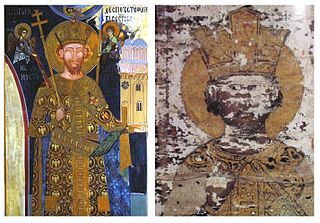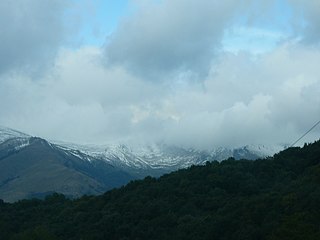 W
WThe Serbian Despotate was a medieval Serbian state in the first half of the 15th century. Although the Battle of Kosovo in 1389 is generally considered the end of medieval Serbia, the Despotate, a successor of the Serbian Empire and Moravian Serbia, lasted for another 60 years, experiencing a cultural and political renaissance before it was conquered by the Ottomans in 1459. Before its conquest the Despotate nominally had a suzerain status to the Ottoman Empire, Byzantine Empire and Kingdom of Hungary. After being fully subjugated to the Ottoman Empire in 1459, it continued to exist in exile in the medieval Kingdom of Hungary until the mid-16th century. Pavle Bakić was the last Despot of Serbia to be recognized by both the Ottoman and the Habsburg Monarchy.
 W
WThe Bakić were a Serbian noble family that initially held estates in Šumadija under Ottoman occupation, then crossed the river and gave its service to the Kingdom of Hungary, becoming one of the leading Serbian noble family in the country, fighting the Ottoman Empire.
 W
WThe Battle of Tripolje, also known as the Battle of Gračanica, was fought in November 1402 between the Serbian Despotate, ruled by the Lazarević dynasty, and the Branković family, aided by the Ottoman Empire.
 W
WThe Banate of Belgrade was a frontier province (banate) of the medieval Kingdom of Hungary, centered in Belgrade. During the second half of the 15th century, and up to 1521, it had a significant role in the anti-Ottoman defensive system of the Kingdom of Hungary.
 W
WThe Crusade of Varna was an unsuccessful military campaign mounted by several European monarchs to check the expansion of the Ottoman Empire into Central Europe, specifically the Balkans between 1443 and 1444. It was called by Pope Eugene IV on 1 January 1443 and led by King Władysław III of Poland, John Hunyadi, Voivode of Transylvania, and Duke Philip the Good of Burgundy.
 W
WThe Despot Stefan Tower or Dizdar Tower is a structure in Belgrade, Serbia, built ca. 1405, a couple of years after the city became the capital of Serbian Despotate under Despot Stefan Lazarević.
 W
WDušan's Code is a compilation of several legal systems that was enacted by Stefan Uroš IV Dušan of Serbia in 1349. It was used in the Serbian Empire and the succeeding Serbian Despotate. It is considered an early constitution, or close to it; an advanced set of laws which regulated all aspects of life.
 W
WThe Jakšić were a Serbian noble family that fought against the Ottoman Empire. The eponymous founder, Jakša, was a Voivode (Duke) in the service of Serbian Despot Đurađ Branković, and after the fall of Serbia to the Ottomans his descendants joined the ranks of the Hungarian army, Hungarian King Matthias Corvinus titled them "pillars of Christianity".
 W
WThe Battle of Kunovica or Battle at Kunovitsa was the battle between crusaders led by John Hunyadi and armies of the Ottoman Empire which took place on 2 or 5 January 1444 near mountain Kunovica between Pirot and Niš.
 W
WManasija, also known as Resava, is a Serbian Orthodox monastery near Despotovac, Serbia, founded by Despot Stefan Lazarević between 1406 and 1418. The church is dedicated to the Holy Trinity. It is one of the most significant monuments of medieval Serbian culture and it belongs to the "Morava school". The monastery is surrounded by massive walls and towers. Immediately following its foundation, the monastery became the cultural centre of the Serbian Despotate. Its School of Resava was well known for its manuscripts and translations throughout the 15th and 16th centuries, even after the fall of the Despotate to the Ottoman Turks. Manasija complex was declared Monument of Culture of Exceptional Importance in 1979, and it is protected by Republic of Serbia, and monastery have entered a UNESCO Tentative List Process in 2010.
 W
WThe Mining Code, Mining Law or Miners' Law or Novo Brdo Code, is a compilation of laws on mining in the Serbian Despotate, enacted by Despot Stefan Lazarević on 29 January 1412, but formulated in 1390. Apart from mining laws, there are legal provisions concerning the organization and life in Novo Brdo, a city which at that time was the largest mine in the Balkans. The compilation survived in several later transcripts, of which a 16th-century illustrated manuscript is regarded as the most important.
 W
WRascians was a common exonym for Serbs during the late medieval and the early modern period. It was used most frequently in the Kingdom of Hungary, and also in the Habsburg Monarchy. The term was derived from the Latinized name for the central Serbian region of Raška. In medieval and early modern Western sources, exonym Rascia was often used as a designation for Serbian lands in general, and consequently the term Rasciani became one of the most common designations for Serbs. Because of the increasing migratory concentration of Serbs in the southern Pannonian Plain, since the late 15th century, those regions also became referred to as Rascia, since they were largely inhabited by Rasciani (Rascians). Among those regions, term Rascia (Raška) was most frequently used for territories spanning from western Banat to central Slavonia, including the regions of Syrmia, Bačka, and southern Baranja. From the 16th to the 18th century, those regions were contested between the Ottoman Empire and the Habsburg Monarchy, and today they belong to several modern countries.
 W
WRaška is a geographical and historical region, covering the south-western parts of modern Serbia, and historically also including north-eastern parts of modern Montenegro, and some of the most eastern parts of modern Bosnia and Herzegovina. In the Middle Ages, the region was a center of the Serbian Principality and of the Serbian Kingdom, whose capital was the city of Ras in the late 12th century.
 W
WThe Second Scutari War was an armed conflict in 1419–1426 between Zeta (1419–1421) and then the Serbian Despotate (1421–1423) on the one side and the Venetian Republic on the other, over Scutari and other former possessions of Zeta captured by Venice.
 W
WThe Siege of Novo Brdo was a military blockade of Novo Brdo, an important fortified mining town in the Serbian Despotate, by the forces of the Ottoman Empire. The siege began in 1440 and lasted until the capture of the fortress on 27 June 1441. During the siege, the Serbian garrison was supported by the local community of citizens of the Republic of Ragusa.
 W
WThe Smederevo Fortress is a medieval fortified city in Smederevo, Serbia, which was temporary capital of Serbia in the Middle Ages. It was built between 1427 and 1430 on the order of Despot Đurađ Branković, the ruler of the Serbian Despotate. It was further fortified by the Ottoman Empire, which had taken the city in 1459.
 W
WSveti Srđ was an important market town on the left bank of the river Bojana 6 miles (9.7 km) away from Skadar in Medieval Serbia and later the Venetian Empire and for short period in the Ottoman Empire. It was a medieval trading center.
 W
WThe Battle of Trnava or Battle of Nagyszombat was a battle in the Hussite Wars between the Hussites and the Hungarian-Royalists-Serbian army near Trnava (Nagyszombat) in the Kingdom of Hungary. The battle was fought in three phases, on 23, 25 and 28 April 1430 and ended in Hussite victory.
 W
WVraćevšnica monastery is a Serbian Orthodox monastery in Vraćevšnica, Gornji Milanovac, Serbia, built in 1428–29 on the orders of Radič, a magnate in the service of Stefan Lazarević and Đurađ Branković. It is part of the Žiča eparchate.
 W
WThe Battle of Zlatitsa was fought on 12 December 1443 between the Ottoman Empire and Serbian Hungarian troops in the Balkans. The battle was fought at Zlatitsa Pass near the town of Zlatitsa in the Balkan Mountains, Ottoman Empire. The impatience of the king of Poland and the severity of the winter then compelled Hunyadi to return home, but not before he had utterly broken the Sultan's power in Bosnia, Herzegovina, Serbia, Bulgaria, and Albania.